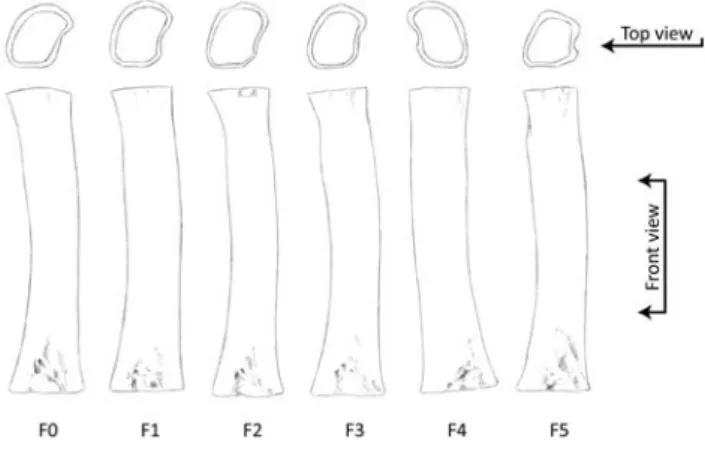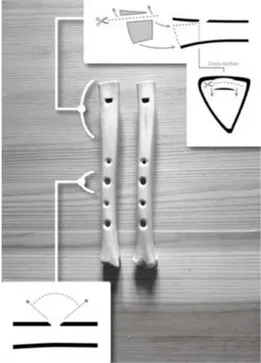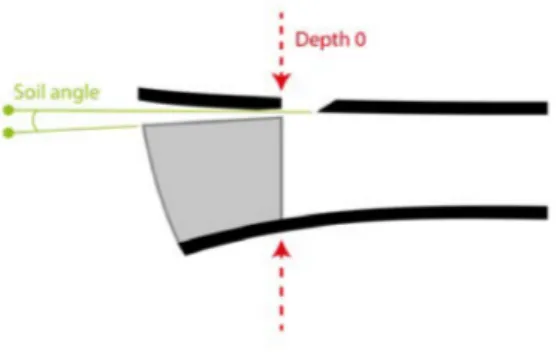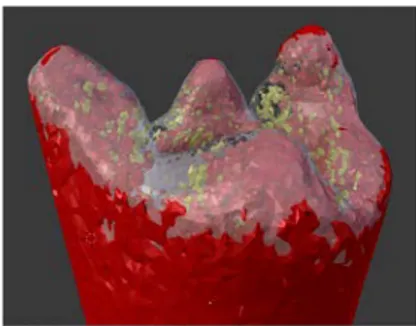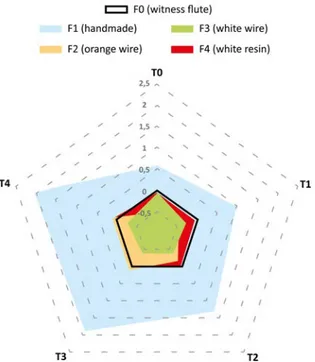HAL Id: hal-01391755
https://hal.archives-ouvertes.fr/hal-01391755
Submitted on 3 Nov 2016
HAL is a multi-disciplinary open access
archive for the deposit and dissemination of
sci-entific research documents, whether they are
pub-lished or not. The documents may come from
teaching and research institutions in France or
abroad, or from public or private research centers.
L’archive ouverte pluridisciplinaire HAL, est
destinée au dépôt et à la diffusion de documents
scientifiques de niveau recherche, publiés ou non,
émanant des établissements d’enseignement et de
recherche français ou étrangers, des laboratoires
publics ou privés.
Digital and handcrafting processes applied to
sound-studies of archaeological bone flutes
Etienne Safa, Jean-Baptiste Barreau, Ronan Gaugne, Wandrille Duchemin,
Jean-Daniel Talma, Bruno Arnaldi, Georges Dumont, Valérie Gouranton
To cite this version:
Etienne Safa, Jean-Baptiste Barreau, Ronan Gaugne, Wandrille Duchemin, Jean-Daniel Talma, et al..
Digital and handcrafting processes applied to sound-studies of archaeological bone flutes. International
Conference on Culturage Heritage, EuroMed, 2016, Nicosia, Cyprus. pp.184-195. �hal-01391755�
sound-studies of archaeological bone flutes
Etienne Safa1, Jean-Baptiste Barreau2,3, Ronan Gaugne4, Wandrille
Duchemin6, Jean-Daniel Talma7, Bruno Arnaldi3, Georges Dumont5, and
Val´erie Gouranton3
1 Universit´e de Bourgogne/ArTeHiS UMR 6298, Dijon, France 2
CNRS/CReAAH UMR 6566, Rennes, France
3 INSA de Rennes/IRISA UMR 6074/Inria-Rennes, Rennes, France 4
Universit´e de Rennes 1/IRISA UMR 6074/Inria-Rennes, Rennes, France
5
ENS de Rennes/IRISA UMR 6074/Inria-Rennes, Rennes, France
6 LBBE UMR CNRS 5558, University of Lyon 1, Lyon, France 7
Atelier El Bock, Chatel-Montagne, France
Abstract. Bone flutes make use of a naturally hollow raw-material. As nature does not produce duplicates, each bone has its own inner cavity, and thus its own sound-potential. This morphological variation implies acoustical specificities, thus making it impossible to handcraft a true and exact sound-replica in another bone. This phenomenon has been observed in a handcrafting context and has led us to conduct two series of experiments (the first-one using handcrafting process, the second-one using 3D process) in order to investigate its exact influence on acoustics as well as on sound-interpretation based on replicas. The comparison of the results has shed light upon epistemological and methodological issues that have yet to be fully understood.
This work contributes to assessing the application of digitization, 3D printing and handcrafting to flute-like sound instruments studied in the field of archaeomusicology.
Keywords: Acoustics, Statistics, Handcrafting, Raw-materials, Digiti-zation, 3D printing, Music archaeology
1
Introduction
Elaborating a research project in close collaboration with a craftsman and a re-search team dedicated to digitization of cultural heritage was the trigger point to different kinds of experiments meant to investigate the morphological variability of bones and its influence on the emitted sounds when carved as flutes. Dealing with this ”Sound-morphology” is the main part of a craftsman’s work, which is why it was decided to run the project of an apprenticeship that would last for one year [18]. During this time, particular attention was paid to the creation and use of prototypes, i.e. a bone flute manufactured in order to try and understand the sound specificities of a particular bone, and then used as a guide in order
to ease the adaptation process. Indeed, each bone has its own morphology and needs to be considered as an individual. The flute-maker proceeds then with a precise observation of each individual and takes every morphological specificity into consideration in order to craft series of bone flutes with similar sounds and identical tuning, even if this has to result in objects that do not look the same. Otherwise, he would risk to create an inefficient object, or a completely different flute.
These observations have raised specific issues regarding the use of bone flute’s replicas for tone scales interpretations in archaeological surveys, as their man-ufacture never seems to take into consideration the bone’s morphology as part of its acoustical specificities ([8], [6] and [16]). They have also led us to conduct ”twin experiments” in the hope of reaching consistent results that would spare no methodological tracks (past, actual and yet-to-come sound-reconstruction methods) in order to explore their limitations as well as their potential. This way, we hope to contribute to better the epistemological landscape of archaeo-logical flute’s research.
The work presented in this paper focuses on the comparison of the sound results given by both series of experiments.
2
Context of the work
2.1 Approach
Flutes are not all the same. They are grouped into several kinds which are distin-guished by the way the air stream is directed toward the edge. Each kind has its own sound aesthetics, but gives also more or less freedom to the flute-player in choosing the pitch and the sound’s characteristics, thanks to the blowing angle variability (Fig. 1). Oblique-, pan-, vessel- and transverse-flutes are amongst the most malleable kinds of flutes. We chose duct-flutes as they are the opposite. In term of organology, these objects can be mentioned as 421.221.12 in the S/H classification system (Sachs/Hornbostel), which means: Internal duct-flute (straight and single) with finger holes and an open end.
Fig. 1: Blowing angle variations regarding two different organological kinds of flutes: a) oblique flute, b) duct-flute
2.2 Partnership
This ”two-front approach” demands to assemble a consistent amount of knowl-edge, which can only be achieved through partnership.
Handcrafting process: the work gathered a traditional flute-maker and a statistician in computational biology.
3D process: the work was based on an existing collaboration between ar-chaeologists and computer scientists on advanced imaging for archaeology, the CNPAO [2]
2.3 Terminology
This paper will use the following terminology according to the acoustical speci-ficities of bone flutes:
Morphology: refers to the natural inner and outer shapes of the bone. Geometry: refers to the handcrafted inner and outer shapes carved
delib-erately or not onto the bone’s surface.
Sound-morphology: refers to the acoustical sections of the morphology, which define the sound potential of the bone (i.e. the inner cavity). By defi-nition, each bone has a different sound-morphology.
Sound-geometry: refers to the acoustical sections of the geometry, which are involved in the definition of the instrument’s final sound, whether they were meant (deliberately carved) or not (unintentional and/or unconscious geometry). As an example: the shapes of the internal duct, of the edge, of the finger holes, etc. By definition, the sound-geometry rules out the outer shaping as long as it does not change the finger holes depth.
T0, T1, T2, etc.: refers to the finger holes’ combination. T0 means all holes closed. T1 means that the lower finger hole (the first one) is open. T2 means that the two lower finger holes (the first and the second one) are open, etc. F0, F1, F2, etc.: systematic identification numbers of the experimental flutes. F0 refers to the control flute, whereas F1, F2, F3, etc. refers to each replica copying the control flute.
2.4 Related works
Nowadays, 3D technologies allow outer and inner contact-free investigation on complex geometries [15]. As such they contribute to answer both preservation and sound studies issues and are more and more used in the actual archaeo-musicological research. If their consequences on our interpretations are still to be defined, they allow different kind of approaches and studies that aim to get a better understanding of ancient sounds. They can be applied to any organolog-ical material [10], such as string instruments ([4], [13], [20] and [21]) but also aerophones ([3], [8], [9] and [11]), among which archaeological ”flutes”, and ob-jects presumed to be flutes, figure ([1], [22], [14], and [23]).
Eventually, the music-archaeology research may even explore new possibilities in sound reconstruction studies, as its data can be applied to sound simulators and sound-scape reconstructions ([24], [12] and [7]).
3
The sound-morphology principle
Naturally hollow rawmaterials, such as bones, hornes, shells or reeds, present a morphological variability between one individual and another. Those variations can be observed both regarding their shapes, their scale and their volumetric and spatial configuration (Fig. 2). Some of them are involved in the sound-morphology. For example, a larger bone will produce a lower pitch for the same length. Likewise, an important and sudden increase or decrease of the bone’s conicity tends to distort the efficiency of a close-range finger-hole.
Fig. 2: Morphological variations between bones used for crafting F0 to F5 in the Hand-crafting process experiments explained below. Deer femurs show several constants, such as a bulge characterizing the distal part of the epiphysis, a triangular and irregular de-pression characterizing its proximal part, and a slimming zone in the concave area of the bone’s bean-like cross-section. Despite those constants, there never are two identical bones.
In order to illustrate this phenomenon, we chose to handcraft a unique replica of a bone flute in another similar bone (Fig. 3).
The control flute was made in a goat’s tibia. It was made very simply, using only steel knife and file, evoking archaeological flutes found in northern Europe for medieval period [5]. The handmade replica was made very carefully, using several measurement tools (caliper, compass, etc.). Also, as the depth of the block changes the pitch, we chose depth 0 (Fig. 4). This calibration is easier to reproduce. We also tried our best to give both blocks a similar soil angle. As a result, the two flutes gave different sounds, with a deviation going from half a tone to more than one tone, increasing as we open the finger holes (Fig. 9 and 10).
This replication test shows how much the sound of a bone flute replica may be deviant from the sound of the control flute it’s related to. This phenomenon
Fig. 3: The control flute (left) and its replica (right) both made out of goat’s tibias.
illustrates the notion of ”sound-morphology” as it reveals that every bone has a sound-potential of its own.
4
Handcrafting experiments
4.1 Handcrafting replication process and technical specifications Objectives: those experiments aim to define the extent of the limitation
caused by sound-morphology, as well as to explore the acoustical specifici-ties of this phenomenon. The approach is then different from what we can see in experimental archaeology, as we need here a well-known, functional and replicable bone flute in order to compare its actual sounds with our interpretations.
Control and sample: we chose 6 similar deer femurs with morphological variations. 5 replicas is the minimum sample required for statistical analysis. Chosen sound-geometry: inner duct-flute with rectangular opening and straight edge (Fig. 5). Combined with a straight geometry, this configuration creates powerful blowing constraints and is easier to reproduce.
Manufacture: handcrafted in January 2016.
Sound capture and analysis: because of lack of means, we had to use a common recording device (smartphone) and a free software (audacity).
Having no mechanical blower nor anechoic chamber available at the time, we had to record the sound using natural blowing (as homogeneous as possible) and the same context (a chosen room). Thankfully, the studied phenomenons are contrasting enough to be well illustrated even with a lack of technical means.
Fig. 4: Illustration of Depth 0 and soil angle
Fig. 5: Depiction of the sound-geometry used for the hand-crafting experiments
4.2 Sound results
The diagrams in Fig. 8 represent the results of basic acoustical analysis of the control flute and its 5 replicas. They obviously show that each individual is different from the control flute.
4.3 Statistics and discussion
The table (Tab. 1) represents statistical analysis made on the recorded frequen-cies. In order to compare them properly, we had to translate them from Hertz to logarithmic scale (base 2 logarithm).
This table shows heterogeneous frequencies and intervals deviations comparing the sample to the control flute, as well as between each individual from the sam-ple itself. Even if the frequency deviations are mostly non-significant regarding statistics (T0 is the only one being significant), the sound estimation they pro-duce is not satisfying for the ear (about one quarter-tone). However, intervals deviations are really small in comparison (about 1/20th of a tone), which is ex-tremely accurate.
1. The lower end of the flute was one of the most variable areas and it was then difficult to reproduce an exact geometry in a changing trabecular bone. This could explain T0 deviation.
2. The small sample size is probably involved in those statistical results: a larger sample (20 to 30 replicas) should help us to get better results and thus assess if whether or not this incredibly accurate estimation of intervals is exact. It should also explain the difference between a satisfying intervals reproduction and an unsatisfying frequencies reproduction.
3. The human blow should be ruled out and replaced by a mechanical blower in order to ensure the accuracy of the sound-capture.
Table 1: Statistical analysis of frequencies emitted by F0 to F5 while playing successively T0, T1 and T2. Differences are expressed in semi-tones (”-1” equals ”1 semi-tone lower”). The right columns show intervals deviations (T0-T1 and T1-T2).
5
3D experiments
5.1 CT-scanning
There exist several possibilities in matter of 3D image acquisition, but CT-scanning was the only viable option because of the very nature of flutes: inner shapes are drastically important and their acoustical properties are extremely sensitive. We needed then a technology that would be able to capture high resolution images both inside and outside of the objects. µ-tomography, also known asµCT, was then the perfect tool. This technology uses X-rays in order to recreate high resolution 3D internal views of an object by compiling the acquired images and is mainly used in medical imaging and industries.
5.2 3D replication process and technical specifications
Objectives: those experiments aim to question the sound-replication capa-bility of 3D technologies in order to define whether or not they may allow us to pass beyond the sound-morphology limitation endured by handcrafting process. They also aim to assess their own limitations and potential as a sound-reconstruction method.
Technologies used:
1. µCT-scanning: the machine is an X-ray microfocus CT system General Electric (formerly Phoenix) v—tome—x 240D from CRT Morlaix, a re-sources center dedicated to metrology (http://www.crt-morlaix.com/). In the set-up, the sample is placed on a rotating table, and the X-ray source and detector are stationary.
2. 3D wire and resin printing: the machines are a MakerBotReplicator2 from IUT Le Creusot, and a Stratasys Mojo from ENS Rennes. The resin model was printed on a 3D Objet by a contractor.
Scanned object: we chose to scan the control flute used in the sound-morphology principle (the one made from a goat’s tibia) in order to compare the 3D results to the handmade replica. The flute was scanned in three parts in order to get a precision of less than 50µ. The reassembly was processed with the software Autodesk Meshmixer. Also, as the trabecular bone renders throughµ-CT scanning as a cloud of 600+ tiny objects, it cannot be directly printed (Fig. 6). We chose to explore two possibilities: simply removing the objects in one case, and integrating them as a 3D sculpted ”patch” in the other (Fig. 7). We used Meshlab and Blender in order to get ready-to-print 3D models.
Fig. 6: Disconnected objects (yel-low) in the area of the trabecular bone.
Fig. 7: 3D sculpted patch (trans-parent gray) on Blender (based on the geometry of the cloud).
Replicas: F1 refers to the handmade replica. F2 refers to the 3D orange wire replica (with 3D sculpted ”patch”, no post-printing treatments). F3 refers to the 3D white wire replica (without the trabecular bone, acetone bath and ultrasounds post-printing treatment). F4 refers to the 3D white resin replica (better printing resolution, with 3D sculpted ”patch”, no post-printing treatments).
Printings: printed between January and May 2016.
Sound capture and analysis: same context than for the handcrafting process.
5.3 Sound results
The diagrams in Fig. 9 represent the results of basic acoustical analysis of the control flute and its four replicas.
Fig. 8: Diagrams analysis of F0 to F5
Fig. 9: Diagrams analysis of F0 to F4
5.4 Analysis and discussion
The following tables represent sound-comparisons between the control flute and its replicas using the recorded frequencies translated from Hertz to base 2 loga-rithm.
Table 2: Comparison between frequencies (top) / intervals (bottom) emitted by F0 to F4 while playing successively T0, T1, T2, T3 and T4. Green cells indicate a sound-reproduction precision of 1/20th of a tone or less.
As we expected, this table shows that 3D printed replicas are globally closest to the original than the handmade one. This is due to the absence of the bone’s
morphological variability that would occur from using several bones. However, they are not identical between each other (Fig. 10).
Fig. 10: Diagram rep-resenting the sound proximity of each replica comparing to the control flute, for each finger hole (numeric scale in semi-tones). The 0 line represents the control flute. The col-ored areas represent the replicas’ sounds. The more the colored area fills the 0 line, the closest the replica is to the control flute.
In Fig. 10, both orange and white wire flutes present a significant but different deviation regarding their emitted frequencies, whereas the resin flute is the most accurate of them all. Indeed, it reaches the sounds of the original with a precision of less than 1/20th of a tone.
As it appears, acoustical phenomenons related to 3D printed replicas seem to be quite intricate. The following facts should thus be considered regarding those results:
1. 3D wire-printing is processed by fusing a plastic filament which is then de-posited by layers, and finally cools down and solidifies. The cooling process comes with a shrinking phenomenon which extent depends on the wire itself as well as on the cooling context (hygrometry and temperature) [17]. Fur-thermore, these deformations may occur in an irregular way. In other words, 3D wire-printing has a morphological variability of its own.
2. 3D resin-printing on the other hand does not work the same and thus does not have the same sources of error [19]: it uses a laser impact which solidifies a gelatinous resin. This technology is more accurate than 3D wire-printing and gives different physical results (smoother state of surface, solid 3D printings). That explains why this replica is much more accurate than the other ones. 3. Once again, human blow should be replaced by a mechanical blower.
6
Conclusion
Handcrafting and 3D replication processes illustrate the acoustical complexity of bone flutes, as well as they raise most important epistemological and methodolog-ical issues. Succinctly, these results advise of the dangers of sound-interpretations regarding ancient flutes when dealing with replicas. They demonstrate the com-plexity of the acoustical phenomenons related to naturally hollow raw-materials. They also demonstrate that 3D imagery is not as precise and trustworthy as we would think it would be. However, the use of statistics and of high-precision 3D printers seems to offer a promising track to continue this research. Although there is still much work to do in order to reach a better understanding of this situation, at least we now know that archaeological bone flutes sounds should always be interpreted with caution. In any case, this research will try and go deeper in the epistemological and methodological issues.
Acknowledgments. This project was partially funded by the french CNRS ImagIn IRMA project.
References
1. Avanzini, F., Canazza, S., De Poli, G., Fantozzi, C., Pretto, N., Roda, A., Menegazzi, A.: Archaeology and virtual acoustics - A pan flute from ancient Egypt, in proceed-ings of the 12th Int. Conference on Sound and Music Computing (2015), 31-36 2. J-B Barreau, R. Gaugne, Y. Bernard, G. Le Cloirec, V. Gouranton, The West
Dig-ital Conservatory of Archaelogical Heritage Project, DH, Marseille, France. DigDig-ital Heritage International Congress, pp. 1-8, Nov. 2013
3. Bellia, A.: The virtual reconstruction of an ancient musical instrument: The aulos of Selinus. In proc. of Digital Heritage, 1 (Sept. 2015), 55-58
4. Borman, T., Stoel, B.: Review of the Uses of Computed Tomography for Analyzing Instruments of the Violin Family with a Focus on the Future, J Violin Soc Am: VSA Papers, 22, 1 (2009), 1-12
5. Brade C.: Die mittelalterlichen Kernspaltfl¨oten Mittel-und Nordeuropas, Ein Beitrage zur ¨Uberlieferung pr¨ahistorischer und zur Typologie mittelalterlicher Kernspaltfl¨oten, Band. 14, Neum¨unster, Wachholtz (1975)
6. Clodor-Tissot T.: Fiche t´emoins sonores du N´eolithique et des ˆAges des m´etaux, Industrie de l’os pr´ehistorique, Instruments sonores du N´eolithique `a l’aube de l’Antiquit´e, XII (2009)
7. Causs R., Mille B., Piechaud R.: Restitution sonore num´erique des cornua de Pom-pei, Sound Making: Handcraft of Musical Instruments in Antiquity, video recordings of the third IFAO conference, IRCAM (2016). http://medias.ircam.fr/x27292e 8. Garca Benito C., Alcolea M., Mazo C.: Experimental study of the aerophone of
Is-turitz: Manufacture, use-wear analysis and acoustic tests, Quaternary International, (2015). http://dx.doi.org/10.1016/j.quaint.2015.11.033
9. Garca Benito C.: Methodology for the reconstruction of prehistoric aerophones made of hard animal material, Actas das IV Jornadas de Jovens em Investiga¸c˜ao Ar-queol´ogica (2011), 411-416
10. Gattoni, F., Melgara, C., Sicola, C., & Uslenghi, C. M.: Unusual application of computerized tomography: the study of musical instruments, La Radiologia medica, 97, 3 (1999), 170-173
11. Hagel S.: The Mero¨e Pipes: a musical jigsaw puzzle, Sound Making: Handcraft of Musical Instruments in Antiquity, video recordings of the third IFAO conference, IRCAM (2016). http://medias.ircam.fr/x9e8e19
12. Hawkins, J., Jacobson, J., Franklin, J.: Greco-Roman Music in Context; Bringing Sound and Music to Virtual Pompeii, World Conference on E-Learning in Corporate, Government, Health Care, and Higher Education (2011)
13. Koumartzis, N., Tzetzis, D., Kyratsis, P., Kotsakis, R. G.: A New Music Instrument from Ancient Times: Modern Reconstruction of the Greek Lyre of Hermes using 3D Laser Scanning, Advanced Computer Aided Design and Audio Analysis. Journal of New Music Research, 44, 4 (2015), 324-346
14. Kunej D., Turk I.: New perspectives on the beginnings of music: Archaeological and musicological analysis of a middle Paleolithic bone ”flute”, The Origins of Music (2000), 235 268
15. Laycock S., Bell G., Mortimore D., Greco M., Corps N., Finkle I.: Combining X-Ray Micro-CT Technology and 3D Printing for the Digital Preservation and Study of a 19th Century Cantonese Chess Piece with Intricate Internal Structure, ACM Journal on Computing and Cultural Heritage, Vol. 5, No. 4 (Oct. 2012)
16. M¨unzel S.C., Seeberger F., Hein W.: The Geissenkl¨osterle flute: discovery, experiments, reconstruction, Studien zur Musikarch¨aologie. Arch¨aologie fr¨uher Klangerzeugung und Tonordnung, Rahden, Verlag M. Leidorf, (2002), p.107 118 17. Pierce Lhotka B.: Hacking the Digital Print: Alternative image capture and
print-making processes with a special section on 3D printing, New Riders, Voices That Matter (2015), 262
18. Safa E.: Handcrafting in archaeomusicological research: record of a one-year ap-prenticeship alongside a traditional-flute-maker and its application to sound archae-ology, Sound Making: Handcraft of Musical Instruments in Antiquity, video record-ings of the third IFAO conference, IRCAM (2016). http://medias.ircam.fr/xcf6cf9 19. Sculpteo: 3D Printing Material: PolyJet Resin, Sculpteos website (2016).
https://www.sculpteo.com/en/materials/polyjet-resin-material/
20. Sirr, S. A., Waddle, J. R.: CT analysis of bowed stringed instruments, Radiology, 203, 3 (1997), 801-805
21. Sodini, N., Dreossi, D., Chen, R., Fioravanti, M., Giordano, A., Herrestal, P., Zanini, F.: Non-invasive microstructural analysis of bowed stringed instruments with synchrotron radiation X-ray microtomography, Journal of Cultural Heritage, 13, 3 (2012), S44-S49
22. Tuniz, C., Bernardini, F., Turk, I., Dimkaroski, L., Mancini, L., Dreossi, D.: Did Neanderthals play music? X-ray computed micro-tomography of the Divje Dabe ’flute’. Archaeometry, 54, 3 (2012), 581-590
23. Turk, I., Blackwell, B. A., Turk, J., Pflaum, M.: Results of computer tomography of the oldest suspected flute from Divje bab I (Slovenia) and its chronological position within global palaeoclimatic and palaeoenvironmental change during last glacial. Anthropologie, 110, 3(2006), 293-317
24. Tzevelekos, P., Georgaki, A., Kouroupetroglou, G.: HERON: a zournas digital virtual musical instrument, in proceedings of the 3rd international conference on Digital Interactive Media in Entertainment and Arts (Sept. 2015), 352-359

